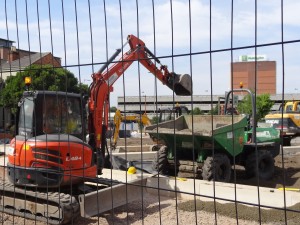 In the blog the service sector continues to drive the UK business cycle written in October 2014 we observed how UK growth was being driven by the service sector while other industrial sectors struggled. The contrasting performance across UK industry appears now to be even more marked. The latest GDP numbers from the Office for National Statistics contained in Gross Domestic Product: Preliminary Estimate, Quarter 4 (Oct to Dec) 2015 show the economy’s output expanded by 0.5 per cent in the fourth quarter. Yet the construction sector is in recession following contractions of 1.9 per cent (Q3) and 0.1 per cent (Q4). Here we update our earlier blog to evidence the UK’s growth paradox.
In the blog the service sector continues to drive the UK business cycle written in October 2014 we observed how UK growth was being driven by the service sector while other industrial sectors struggled. The contrasting performance across UK industry appears now to be even more marked. The latest GDP numbers from the Office for National Statistics contained in Gross Domestic Product: Preliminary Estimate, Quarter 4 (Oct to Dec) 2015 show the economy’s output expanded by 0.5 per cent in the fourth quarter. Yet the construction sector is in recession following contractions of 1.9 per cent (Q3) and 0.1 per cent (Q4). Here we update our earlier blog to evidence the UK’s growth paradox.
Preliminary estimates suggest that the UK economy expanded by 0.5 per cent in the final quarter of 2015 following on from growth of of 0.4 per cent in the third quarter. 2015 as a whole saw output grow by 2.2 per cent, down from 2.9 per cent in 2014 and a little below the average over the past 60 years of around 2.6 per cent.
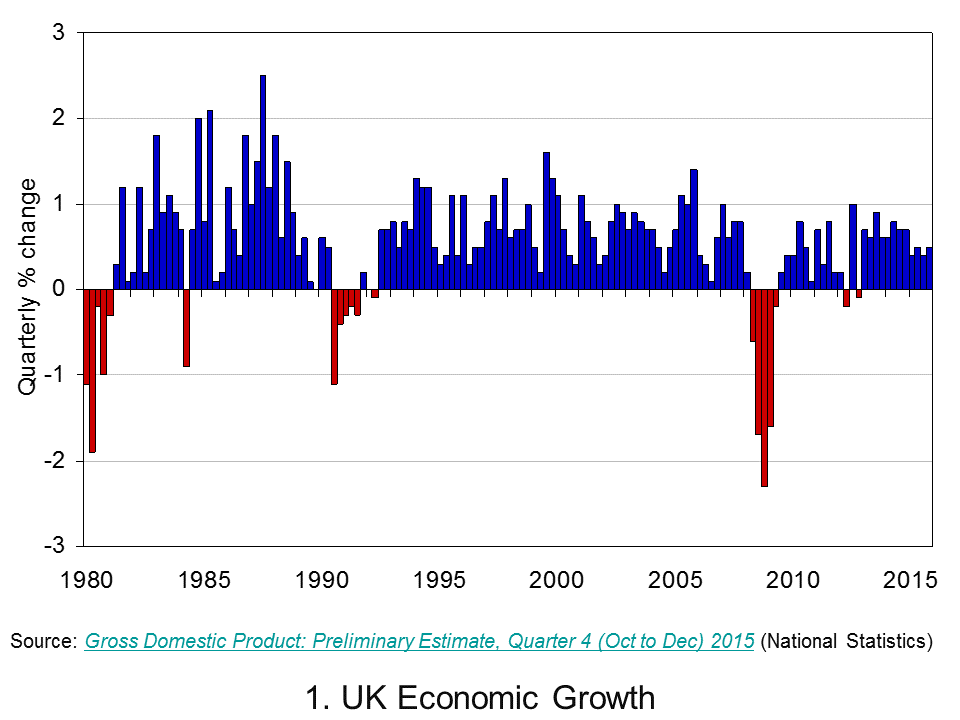 Chart 1 shows quarterly economic growth since 1980s (Click here for a PowerPoint of the chart). It illustrates nicely the inherent volatility of economies – one of the threshold concepts in economics.The average quarterly rate of growth since 1980 has been 0.5 per cent so on the face of it, a quarterly growth number of 0.5 per cent might seem to paint a picture of sustainable growth. Yet, the industrial make up of growth is far from balanced.
Chart 1 shows quarterly economic growth since 1980s (Click here for a PowerPoint of the chart). It illustrates nicely the inherent volatility of economies – one of the threshold concepts in economics.The average quarterly rate of growth since 1980 has been 0.5 per cent so on the face of it, a quarterly growth number of 0.5 per cent might seem to paint a picture of sustainable growth. Yet, the industrial make up of growth is far from balanced.
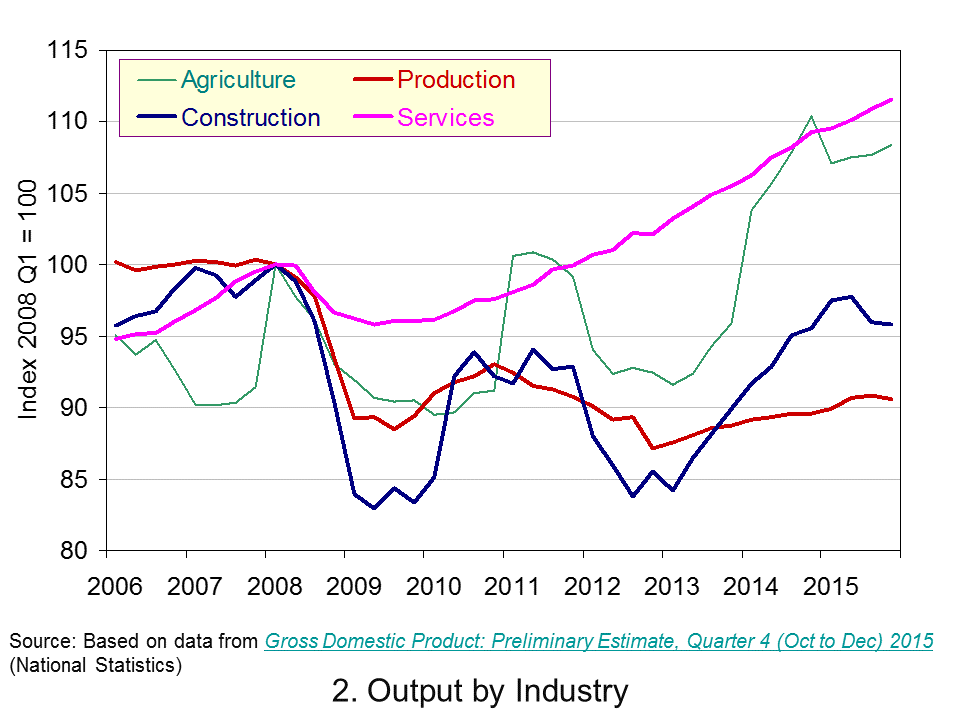 Consider now Chart 2 (Click here for a PowerPoint of the chart). It allows us to analyse more recent events by tracking how industrial output has evolved since 2006. It suggests an unbalanced recovery following the financial crisis. In 2015 Q4 the economy’s total output was 6.6 per cent higher than in 2008 Q1 with service-sector output 11.6 per cent higher. However, a very different picture emerges for the other principal industrial types.
Consider now Chart 2 (Click here for a PowerPoint of the chart). It allows us to analyse more recent events by tracking how industrial output has evolved since 2006. It suggests an unbalanced recovery following the financial crisis. In 2015 Q4 the economy’s total output was 6.6 per cent higher than in 2008 Q1 with service-sector output 11.6 per cent higher. However, a very different picture emerges for the other principal industrial types.
The economy’s total output surpassed its 2008 Q1 peak in 2013 Q2, but output across the production industries in 2015 Q4 remains 9.4 per cent lower than in 2008 Q1 (and 6.4 per cent lower specifically within manufacturing) and 4.2 per cent lower in the construction sector. However, output in the agricultural sector has rebounded and is now 8.4 per cent higher than in 2008 Q1.
The growth data continue to show the British economy struggling to rebalance its industrial composition. With output in construction in 2015 Q4 2 per cent lower than it was in Q2 and manufacturing output 0.4 per cent lower, UK growth remains stubbornly dependent on the service sector.
Data
Preliminary Estimate of GDP – Time Series Dataset Quarter 4 (Oct to Dec) 2015 Office for National StatisticsGross Domestic Product: Preliminary Estimate, Quarter 4 (Oct to Dec) 2015 Office for National Statistics
Economy tracker: GDP BBC News
Articles
UK economic growth slows in 2015: what the economists are saying Guardian, Katie Allen (28/1/16)
UK economy grows 0.5% in fourth quarter BBC News, (28/1/16)
Bumpy times ahead’ for UK even as fourth quarter growth accelerates Telegraph, Szu Ping Chan (28/1/16)
UK economic growth rises to 0.5% in fourth quarter The Scotsman, Roger Baird (28/1/16)
GDP growth picks up to 0.5% but only the services sector comes to the party Independent, Ben Chu (29/1/16)
Questions
- What is the difference between nominal and real GDP? Which of these helps to track changes in economic output?
- Looking at Chart 1 above, summarise the key patterns in real GDP since the 1980s.
- What is a recession?
- What are some of the problems with the traditional definition of a recession?
- Can a recession occur if nominal GDP is actually rising? Explain your answer.
- What factors lead to economic growth being so variable?
- What factors might explain the very different patterns seen since the late 2000s in the volume of output of the four main industrial sectors?
- What different interpretations could there be of a ‘rebalancing’ of the UK economy?
- What other data might we look at to analyse whether the UK economy is ‘rebalancing’?.
- Do the different rates of growth across the industrial sectors of the UK matter?
- Produce a short briefing paper exploring the prospects for economic growth in the UK over the next 12 to 18 months.
- What is the difference between GVA and GDP?
- Explain the arguments for and against using GDP as a measure of a country’s economic well-being.
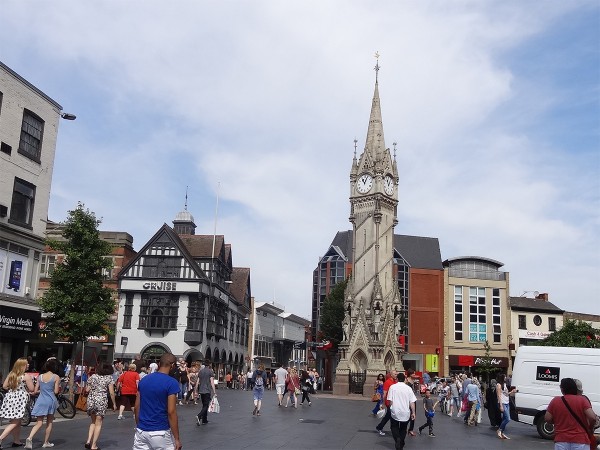 The latest GDP numbers from the Office for National Statistics contained in Quarterly National Accounts, Q2 2014 show the economy’s output expanded by 0.9 per cent in the second quarter. This follows on the back of a 0.7 per cent increase in output in Q1 2014. The economy’s output is now thought to be 0.7 per cent above its Q1 2008 peak. Yet, the data show very different profiles for the four principal industrial sectors. The service sector appears to be ploughing ahead while the rest (production, construction and agriculture) lag behind.
The latest GDP numbers from the Office for National Statistics contained in Quarterly National Accounts, Q2 2014 show the economy’s output expanded by 0.9 per cent in the second quarter. This follows on the back of a 0.7 per cent increase in output in Q1 2014. The economy’s output is now thought to be 0.7 per cent above its Q1 2008 peak. Yet, the data show very different profiles for the four principal industrial sectors. The service sector appears to be ploughing ahead while the rest (production, construction and agriculture) lag behind.
 Chart 1 shows quarterly economic growth since 1980s (click here for a PowerPoint of the chart). It illustrates nicely the inherent volatility of economies – one of the threshold concepts in economics. The average quarterly rate of growth since 1980 has been 0.5 per cent. On the face of it, a quarterly growth number of 0.9 per cent would appear very robust. Of course, this has to been set in the context of the 2008/9 recession. UK output peaked in Q1 2008 (£414.424 billion at 2011 prices). The revised data now show that there followed 5 quarters of declining output (previously, data suggested the duration of the recession was 6 quarters). During this period output shrank 6 per cent (GDP at 2011 prices had fallen by Q2 2009 to £389.388 billion ).
Chart 1 shows quarterly economic growth since 1980s (click here for a PowerPoint of the chart). It illustrates nicely the inherent volatility of economies – one of the threshold concepts in economics. The average quarterly rate of growth since 1980 has been 0.5 per cent. On the face of it, a quarterly growth number of 0.9 per cent would appear very robust. Of course, this has to been set in the context of the 2008/9 recession. UK output peaked in Q1 2008 (£414.424 billion at 2011 prices). The revised data now show that there followed 5 quarters of declining output (previously, data suggested the duration of the recession was 6 quarters). During this period output shrank 6 per cent (GDP at 2011 prices had fallen by Q2 2009 to £389.388 billion ).
Chart 1 highlights two earlier downturns. First, there is the recession of the early 1980s. We can see the 5-quarter recession that commenced in Q1 1980. By the end of this recession output had shrunk by 4.5 per cent. Second, there is the recession of the early 1990s which commenced in Q3 1990. Again, this recession lasted five quarters. By the time the economy had come out of recession it had shrunk 2.2 per cent.
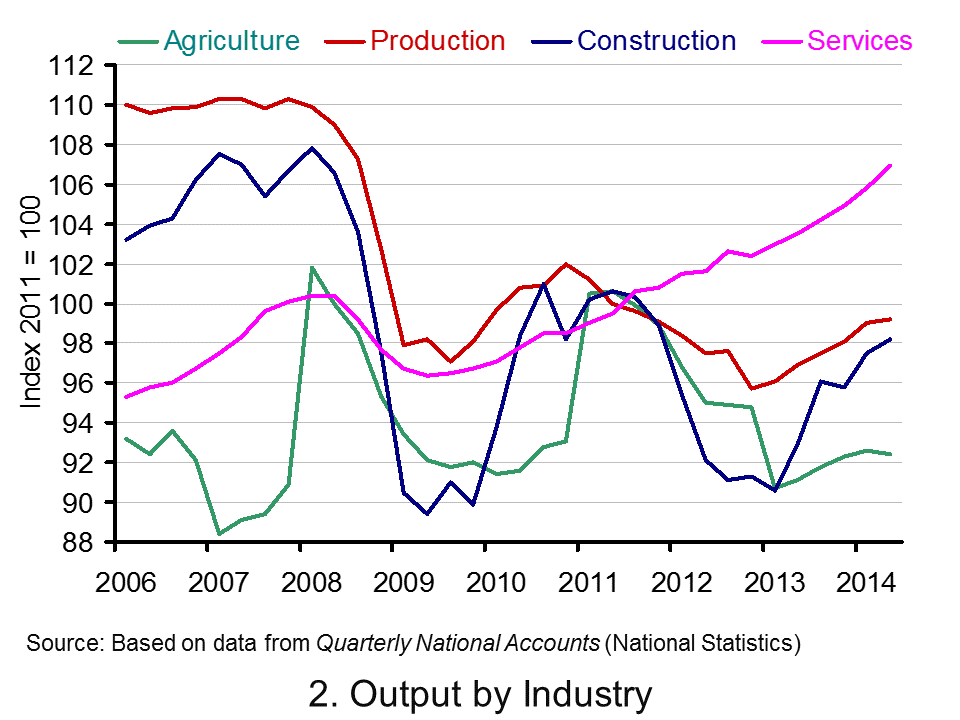 Consider now Chart 2 (click here for a PowerPoint of the chart). It allows us to analyse more recent events by tracking how industrial output has evolved since 2006. It suggests an unbalanced recovery. From it, we observe that in Q2 2014 service-sector output was 6.5 per cent higher than in Q1 2008. However, a very different picture emerges for the other principal industrial types. Output across the production industries remains 9.7 per cent lower, 9.2 per cent lower in agriculture and 8.9 per cent lower in the construction sector.
Consider now Chart 2 (click here for a PowerPoint of the chart). It allows us to analyse more recent events by tracking how industrial output has evolved since 2006. It suggests an unbalanced recovery. From it, we observe that in Q2 2014 service-sector output was 6.5 per cent higher than in Q1 2008. However, a very different picture emerges for the other principal industrial types. Output across the production industries remains 9.7 per cent lower, 9.2 per cent lower in agriculture and 8.9 per cent lower in the construction sector.
In short, the British economy continues to struggle to rebalance its industrial base. The business cycle remains heavily dependent on the service sector.
Articles
UK GDP revised up: what the economists say Guardian, Katie Allen (30/9/14)
UK economy grew 0.9% in second quarter, says ONS BBC News, Katie Allen (9/5/14)
UK GDP: Did the UK economy do well after all? Independent, Ben Chu (30/9/14)
UK economy grew 0.9% Herald, Ian McConnell (1/10/14)
Economy tracker: GDP BBC News (30/9/14).
Data
Quarterly National Accounts, Q2 2014 Dataset Office for National StatisticsQuarterly National Accounts, Q2 2014, Statistical Release Office for National Statistics
Questions
- What is the difference between nominal and real GDP? Which of these helps to track changes in economic output?
- Looking at Chart 1 above, summarise the key patterns in real GDP since the 1980s.
- What is a recession?
- What are some of the problems with the traditional definition of a recession?
- Can a recession occur if nominal GDP is actually rising? Explain your answer.
- What factors lead to economic growth being so variable?
- What factors might explain the very different patterns seen since the late 2000s in the volume of output of the four main industrial sectors?
- What different interpretations could there be of a ‘rebalancing’ of the UK economy?
- What other data might we look at to analyse whether the UK economy is ‘rebalancing’?.
- Produce a short briefing paper exploring the prospects for economic growth in the UK over the next 12 to 18 months.
- What is the difference between GVA and GDP?
- Explain the arguments for and against using GDP as a measure of a country’s economic well-being.
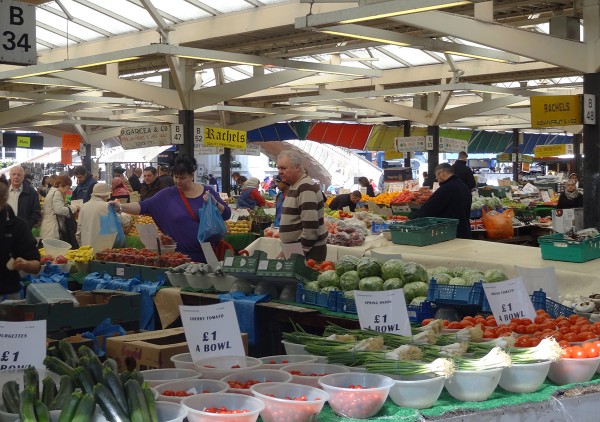 The latest preliminary GDP estimates for 2014 Q1 suggest that the economy’s output (real GDP) expanded by 0.8 per cent following on the back of a 0.7 per cent increase in 2013 Q4. Growth was observed in three of the four main industrial sectors: 0.9% in services, 0.8% in production and 0.3% in construction. In contrast, output decreased by 0.7% in agriculture. The total output of the economy is now just 0.6 per cent below its 2008 Q1 peak with the output of the service sector now 2.0 per cent higher.
The latest preliminary GDP estimates for 2014 Q1 suggest that the economy’s output (real GDP) expanded by 0.8 per cent following on the back of a 0.7 per cent increase in 2013 Q4. Growth was observed in three of the four main industrial sectors: 0.9% in services, 0.8% in production and 0.3% in construction. In contrast, output decreased by 0.7% in agriculture. The total output of the economy is now just 0.6 per cent below its 2008 Q1 peak with the output of the service sector now 2.0 per cent higher.
Data on growth need to be set in the context of the inherent volatility of economies and in this case in the context of 2008/9 recession. Then, output fall by some 7.2 per cent. UK output peaked in 2008 Q1 (£392.786 billion at 2010 prices). There then followed 6 quarters during which output declined.
Output declined again in 2010 Q4 (-0.2% growth), in 2011 Q4 (-0.1% growth), in 2012 Q2 (-0.4%) and in 2012 Q4 (-0.2%). A double-dip recession was only narrowly avoided with growth recorded at zero on 2012 Q1. The latest ONS numbers show the economy grew by 0.8 per cent in 2013 Q2 (to £381.318 billion at 2010 prices), by 0.8 per cent in 2013 Q3 (to £384.533 billion at 2010 prices), by 0.7 per cent in 2013 Q4 (to £387.138 billion at 2010 prices) and by 0.8 per cent in 2014 Q1 (to £390.235 billion at 2010 prices). Compared with 2013 Q1, the output of the UK economy in 2014 Q1 is 3.1 per cent higher.
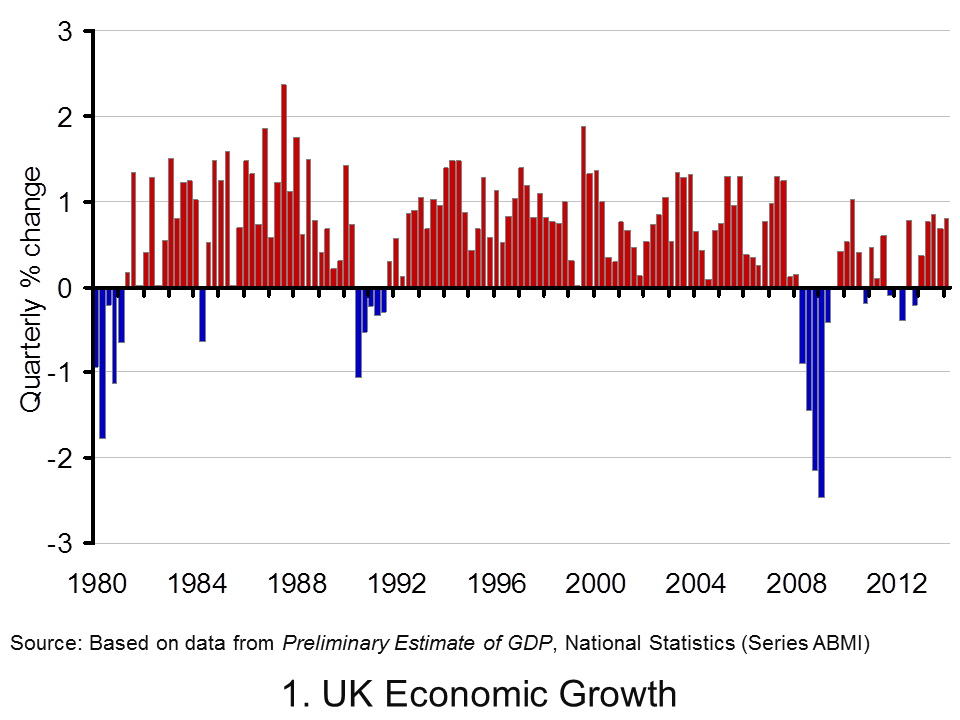 Chart 1 helps to put the recent growth numbers into an historical context. It shows the quarterly change in real GDP since the 1980s. We can see the 5-quarter recession that commenced in 1980 Q1 when output shrunk by 4.6 per cent, the 5-quarter recession that commenced in 1990 Q3 when output shrank by 2.4 per cent and the 6-quarter recession that commenced in 2008 Q2 when output shrank by 7.2 per cent. (Click here to download the chart to PowerPoint.)
Chart 1 helps to put the recent growth numbers into an historical context. It shows the quarterly change in real GDP since the 1980s. We can see the 5-quarter recession that commenced in 1980 Q1 when output shrunk by 4.6 per cent, the 5-quarter recession that commenced in 1990 Q3 when output shrank by 2.4 per cent and the 6-quarter recession that commenced in 2008 Q2 when output shrank by 7.2 per cent. (Click here to download the chart to PowerPoint.)
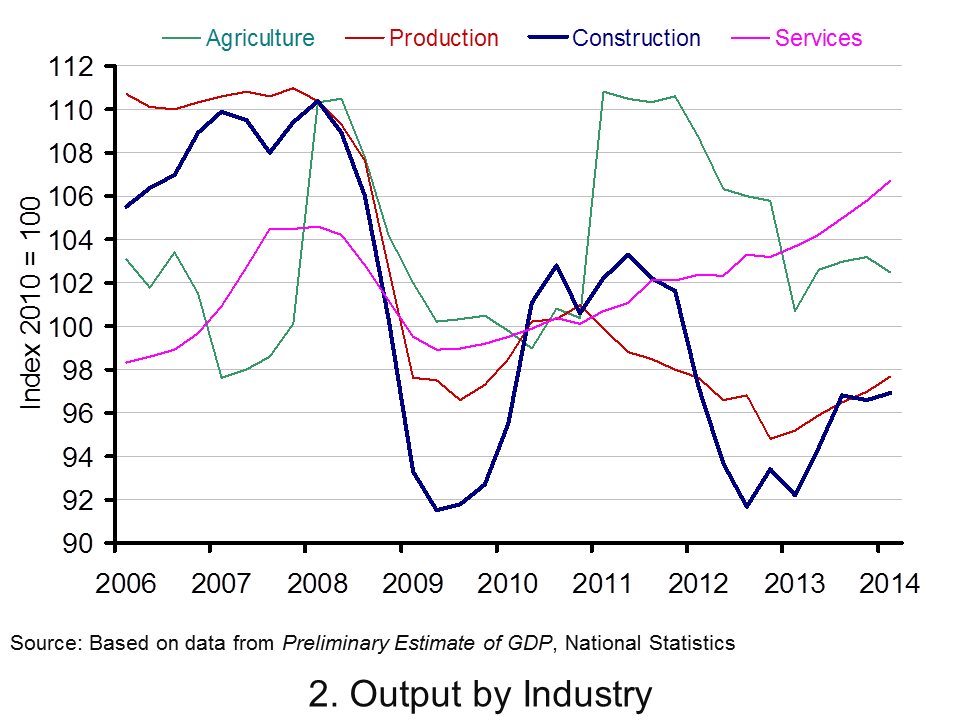 Chart 2 scratches a little below the surface by looking at output by the 4 principal industrial types. The interesting finding is that the output of the service sector has now risen above its 2008 Q1 peak. In 2014 Q1, service sector output was 2.0 per cent higher than 2008 Q1. The fact that total output remains 0.6 per cent lower can be explained by the lop-sided industrial recovery. Output in agriculture, forestry and fisheries remains 7.1 per cent lower, production (including manufacturing) 11.5 per cent lower and construction 12.2 per cent lower. (Click here to dowload the chart to Powerpoint.)
Chart 2 scratches a little below the surface by looking at output by the 4 principal industrial types. The interesting finding is that the output of the service sector has now risen above its 2008 Q1 peak. In 2014 Q1, service sector output was 2.0 per cent higher than 2008 Q1. The fact that total output remains 0.6 per cent lower can be explained by the lop-sided industrial recovery. Output in agriculture, forestry and fisheries remains 7.1 per cent lower, production (including manufacturing) 11.5 per cent lower and construction 12.2 per cent lower. (Click here to dowload the chart to Powerpoint.)
Data
Preliminary Estimate of GDP – Time Series Dataset Q1 2014 Office for National StatisticsGross Domestic Product Preliminary Estimate, Q1 2014 Office for National Statistics
Articles
UK GDP ‘close to pre-crisis level’ says NIESR BBC News (9/5/14)
UK ‘great recession’ almost over, says thinktank Guardian, Katie Allen (9/5/14)
UK economy tops its pre-crash high point, says NIESR Telegraph, Szu Ping Chan (9/5/14)
UK economy grew by 0.8% in first three months of 2014 Guardian, Katie Allen and Angela Monaghan (29/4/14)
Manufacturing is GDP star performer BBC News, Robert Peston (29/4/14).
Questions
- What is the difference between nominal and real GDP? Which of these helps to track changes in economic output?
- Looking at Chart 1 above, summarise the key patterns in real GDP since the 1980s.
- What is a recession? What is a double-dip recession?
- What are some of the problems with the traditional definition of a recession?
- Can a recession occur if nominal GDP is actually rising? Explain your answer.
- What factors lead to economic growth being so variable?
- What factors might explain the very different patterns seen since the late 2000s in the volume of output of the 4 main industrial sectors?
- Produce a short briefing paper exploring the prospects for economic growth in the UK over the next 12 to 18 months.
- Explain the arguments for and against using GDP as a measure of a country’s economic well-being.
- Analyse the role that the financial system might play in contributing to or alleviating the business cycle.
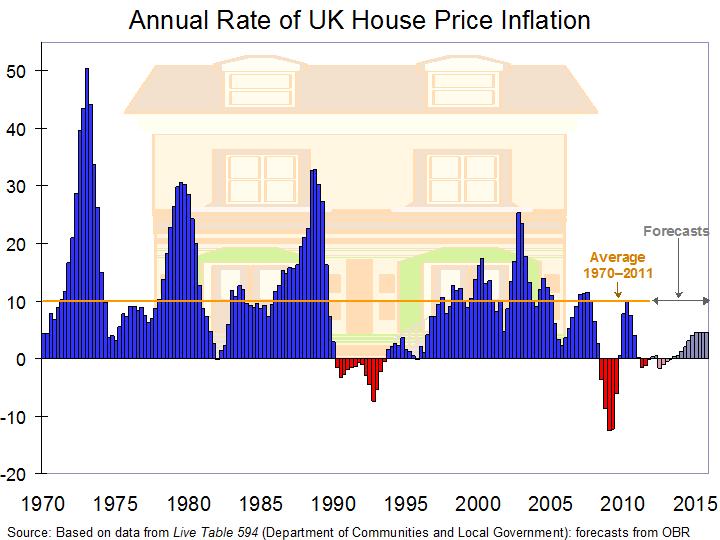 The housing market has long been seen as a crucial element in stimulating the British economy. For this reason various incentives had been introduced to encourage people to buy properties. (Click here for a PowerPoint of the chart.)
The housing market has long been seen as a crucial element in stimulating the British economy. For this reason various incentives had been introduced to encourage people to buy properties. (Click here for a PowerPoint of the chart.)
One such strategy was the stamp duty holiday. Stamp Duty Land Tax is paid by the purchaser of a property against a purchase price and the cost of it will rise through each price band. The stamp duty holiday meant that first-time buyers were free from the 1% stamp duty on homes that cost under £250,000. However, this holiday is due to end from March 2012, as according to the government, the holiday has been ineffective. Indeed, in the Autumn statement documents, the government said:
‘The government is publishing analysis showing that the stamp duty land tax relief for first-time buyers has been ineffective in increasing the number of first time buyers entering the market.’
The government has said that instead it will focus on other strategies that provide better value for money. Such schemes include a mortgage guarantee scheme and the FirstBuy scheme launched last year, both of which aim to help those struggling to finance the purchase of their first properties.
According to the Land Registry, property prices have fallen by over 1% over the past year, so fewer properties will face the stamp duty land tax, but this data does little to instill confidence in the housing market being the stimulus that the economy needs. By stimulating the housing market, construction jobs should be created and this in turn should create a much needed multiplier effect helping to boost other sectors within the economy. The following articles consider this latest development.
Stamp duty rush boosts January valuations Mortgage Strategy, Tessa Norman (11/2/12)
New deals for buyers as stamp duty holiday ends BBC News, Susannah Streeter (11/2/12)
Autumn Statement: Stamp duty concession to end BBC News (29/11/11)
First-time buyers boost mortgage market activity FT Adviser, Michael Trudeau (9/2/12)
When shared ownership turns sour Guardian, Rupert Jones (10/2/12)
Questions
- Why does the housing market play such a crucial role in the economy?
- What is the multiplier effect? How will new jobs in the construction industry help other sectors in the economy?
- Why has the stamp duty holiday been ‘ineffective’ in stimulating the housing market?
- How have the other schemes introduced by the government created incentives in the housing market?
- Why have January valuations improved? Use a demand and supply diagram to illustrate your explanation.
The housing market has been very volatile over the past year or so. House prices crashed, but then appeared to stabilise. Since then, however, different sources have given very different opinions and predictions about future movements. According to Nationwide Building Society, house prices have increased by an average of £53 a day during September, but others suggest that they remain stable and that they may fall again in 2010.
Not only are house prices important to those buying and selling, but the state of the housing market is also crucial for the recovery of the economy. For example, the construction industry has suffered over the past year and, as of the 2nd October 2009, unemployment in this sector stood at 17.1%. As more and more workers lose their jobs, their disposable income falls and hence demand in the economy is affected. With the possibility of an election debate between the party leaders, many will be waiting to see what their strategies are to revitalise a struggling economy.
House prices rise an average of £53 a day’ Daily Record, Clinton Manning (3/10/09)
Mortgage approvals dip in August BBC News (29/9/09)
Construction contracts at slowest pace for seven months Construction News, Nick Whitten (5/5/09)
House sales ‘stalled’ in August BBC News (22/9/09)
Housing market needs ‘feel-good’ factor to recover City Wire, Nicholas Paler (26/6/09)
Double whammy for first-timers as prices stabilise and loans dry up Scotsman, Jeff Salway (3/10/09)
Head-to-head view on house prices BBC News, Kevin Peachey (27/8/09)
UK construction industry still contracting, says Cips Guardian, Kathryn Hopkins (2/10/09)
House prices see ‘slight decline’ BBC News (28/9/09)
House prices ‘back to 2008 level’ BBC News (2/10/09)
Construction unemployment rises to 17.1% HomeTown Sources (2/10/09)
House prices up – but so are insolvencies Management Today (2/10/09)
Financial shadow cast by city apartments BBC News (8/10/09)
For house price data see:
Nationwide House Prices
Halifax House Price Index from the Lloyds Banking Group
Housing Market and House Prices from the Department of Communites and Local Government
Questions
- Why are recent movements in the housing market going to be a problem for first-time buyers?
- The ‘Stamp duty holiday’ will soon come to an end. What do you think will be the impact on the demand for and supply of houses and hence equilibrium prices over the next 6 months?
- One of the reasons why house prices have stabilised is a lack of supply. How does this affect equilibrium prices?
- Why is the economy so affected by changes in house prices? Think about what happens when construction workers lose their jobs and how this affects aggregate demand. Then consider how the macroeconomy will be affected.
- When demand for houses increases, why do prices increase so rapidly? Consider elasticity.
 In the blog the service sector continues to drive the UK business cycle written in October 2014 we observed how UK growth was being driven by the service sector while other industrial sectors struggled. The contrasting performance across UK industry appears now to be even more marked. The latest GDP numbers from the Office for National Statistics contained in Gross Domestic Product: Preliminary Estimate, Quarter 4 (Oct to Dec) 2015 show the economy’s output expanded by 0.5 per cent in the fourth quarter. Yet the construction sector is in recession following contractions of 1.9 per cent (Q3) and 0.1 per cent (Q4). Here we update our earlier blog to evidence the UK’s growth paradox.
In the blog the service sector continues to drive the UK business cycle written in October 2014 we observed how UK growth was being driven by the service sector while other industrial sectors struggled. The contrasting performance across UK industry appears now to be even more marked. The latest GDP numbers from the Office for National Statistics contained in Gross Domestic Product: Preliminary Estimate, Quarter 4 (Oct to Dec) 2015 show the economy’s output expanded by 0.5 per cent in the fourth quarter. Yet the construction sector is in recession following contractions of 1.9 per cent (Q3) and 0.1 per cent (Q4). Here we update our earlier blog to evidence the UK’s growth paradox. Chart 1 shows quarterly economic growth since 1980s (Click here for a PowerPoint of the chart). It illustrates nicely the inherent volatility of economies – one of the threshold concepts in economics.The average quarterly rate of growth since 1980 has been 0.5 per cent so on the face of it, a quarterly growth number of 0.5 per cent might seem to paint a picture of sustainable growth. Yet, the industrial make up of growth is far from balanced.
Chart 1 shows quarterly economic growth since 1980s (Click here for a PowerPoint of the chart). It illustrates nicely the inherent volatility of economies – one of the threshold concepts in economics.The average quarterly rate of growth since 1980 has been 0.5 per cent so on the face of it, a quarterly growth number of 0.5 per cent might seem to paint a picture of sustainable growth. Yet, the industrial make up of growth is far from balanced.  Consider now Chart 2 (Click here for a PowerPoint of the chart). It allows us to analyse more recent events by tracking how industrial output has evolved since 2006. It suggests an unbalanced recovery following the financial crisis. In 2015 Q4 the economy’s total output was 6.6 per cent higher than in 2008 Q1 with service-sector output 11.6 per cent higher. However, a very different picture emerges for the other principal industrial types.
Consider now Chart 2 (Click here for a PowerPoint of the chart). It allows us to analyse more recent events by tracking how industrial output has evolved since 2006. It suggests an unbalanced recovery following the financial crisis. In 2015 Q4 the economy’s total output was 6.6 per cent higher than in 2008 Q1 with service-sector output 11.6 per cent higher. However, a very different picture emerges for the other principal industrial types.





